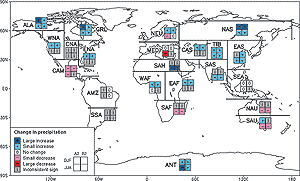| Table 4: Estimates of confidence in observed and
projected changes in extreme weather and climate events. The table depicts
an assessment of confidence in observed changes in extremes of weather and
climate during the latter half of the 20th century (left column) and in
projected changes during the 21st century (right column)a. This
assessment relies on observational and modelling studies, as well as physical
plausibility of future projections across all commonly used scenarios and
is based on expert judgement (see Footnote
4). [Based upon Table 9.6] |
 |
|
Confidence in observed changes (latter half of the
20th century)
|
Changes in Phenomenon
|
Confidence in projected changes (during the 21st
century)
|
 |
| Likely |
Higher maximum temperatures and more hot days over nearly all land
areas |
Very likely |
| Very likely |
Higher minimum temperatures, fewer cold days and frost days over nearly
all land areas |
Very likely |
| Very likely |
Reduced diurnal temperature range over most land areas |
Very likely |
| Likely, over many areas |
Increase of heat index8
over land areas |
Very likely, over most areas |
| Likely, over many Northern Hemisphere mid- to high latitude land areas |
More intense precipitation eventsb |
Very likely, over many areas |
| Likely, in a few areas |
Increased summer continental drying and associated risk of drought |
Likely, over most mid-latitude continental interiors (Lack of consistent
projections in other areas) |
| Not observed in the few analyses available |
Increase in tropical cyclone peak wind intensitiesc |
Likely, over some areas |
| Insufficient data for assessment |
Increase in tropical cyclone mean and peak precipitation intensitiesc |
Likely, over some areas |
 |
